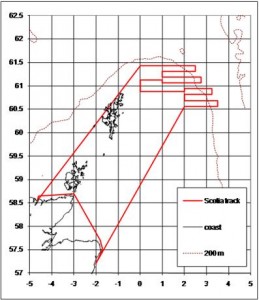Marine
MRV Scotia: 1514S and 1614S – Mackerel surveys
October 8, 2014 by Marine Scotland Communications No Comments | Category Fisheries, Marine Directorate general, Marine Directorate Science, Research Vessel Surveys
Loading: Aberdeen, 8 October 2014, Departure: Aberdeen, 11 October 2014
Arrival and unloading: Aberdeen, 23 October 2014
Sampling Gear
- Midwater trawl PT160 x 2
- Edgetech broadband towed system
- Seabird 911 CTD
- Go-pro camera system with additional sensors (depth, temp, attitude etc)
- Towed hydrophone array
Overall Objectives
- To investigate the use of a broadband system as a means to determine mackerel size
- To estimate mackerel density and abundance.
- To study distribution of cetaceans and their relationship to mackerel shoals
Specific Objectives
- Calibration of Broadband system.
- Obtain acoustic data from mackerel using the broadband system
- Obtain echosounder recordings of mackerel schools and map their distribution.
- Obtain biological samples of mackerel from schools by trawling
- Calibrate Sv and TS gains on the Simrad EK60
- Deploy a Go- Pro camera system with additional sensors into the mackerel schools to observe behaviour
- Observe marine mammal distribution and activity during daylight hours
- Obtain towed hydrophone recordings of mammal vocalisation during survey transects.
Procedure
All gear will be loaded in Aberdeen on 8 October. The vessel will depart Aberdeen on 11 October and make passage for Loch Erribol, where a calibration of all drop keel mounted acoustic transducers will take place. During calibration, an investigation of the acoustic output of the broadband system will be attempted using a standard target below the suspended towed body. In the event that there is insufficient depth for this exercise in the selected anchorage, and weather permits, this may be done in the open sea with the vessel drifting.
Scotia will make her way to the survey area after the calibration has been completed. The proposed survey area is shown in Figure 1. However, this is based on the expected position of the Scottish pelagic fleet which will be fishing for mackerel at this time. The survey will follow a pattern of parallel transects running east/west, at normal steaming speed (approximately 10.5 knots) until an area with suitable shoals is found. Work using the broadband system will then be concentrated in that area.
Acoustic data will be collected at four frequencies (18, 38, 120 and 200 kHz) on a 24 hour basis. While transecting, a towed hydrophone array will be deployed over the stern of the vessel and will be recovered prior to any fishing operations.
Fish shoals seen on the echosounder will be identified using a pelagic trawl (PT160). Trawling operations will be carried out up to twice per day at anytime between 0900 and 2100. The vessels netsonde systems will be required to monitor catch density and position of shoals in the water column during trawling. The SH80 sonar will be used to collect acoustic data and direct fishing operations.
Biological sampling of all species caught will be carried out as per standard sampling protocol.
A vertical CTD dip will be carried out immediately following a pelagic trawl, this will require the vessel to use its DP system to remain on station.
Deployment into mackerel schools of the fishing rod mounted Go-Pro camera/sensor system will be done either in DP or with vessel drifting depending on the conditions. Where schools are shallow the GO-Pro system may be net mounted during tows.
The ships thermosalinograph will be run continuously to obtain sea surface temperature and salinity throughout the survey area.
Scotia will be unloaded of fishing and scientific gear on her return to Aberdeen on Thursday 23 October.
Related Information:
Where’s the Scotia? :
http://www.sailwx.info/shiptrack/shipposition.phtml?call=MINUK05



Leave a comment